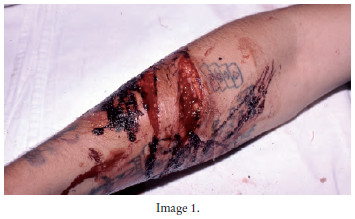My SciELO
Services on Demand
Journal
Article
Indicators
-
 Cited by SciELO
Cited by SciELO -
 Access statistics
Access statistics
Related links
-
 Cited by Google
Cited by Google -
 Similars in
SciELO
Similars in
SciELO -
 Similars in Google
Similars in Google
Share
Revista Española de Sanidad Penitenciaria
On-line version ISSN 2013-6463Print version ISSN 1575-0620
Rev. esp. sanid. penit. vol.17 n.3 Barcelona 2015
https://dx.doi.org/10.4321/S1575-06202015000300005
Subcultural manifestations of self-injury in correctional settings
Manifestaciones subculturales de la autolesión en el medio penitenciario
J.M. Arroyo-Cobo
General Sub-Directorate for the Coordination of Prison Health
General Secretariat of Penitentiary Institutions
Self-injury, defined as the act of deliberately harming your own body, is a common behavior among certain groups of inmates1. This is determined because among the imprisoned population there are a series of related factors which are more common than in the general population. On one hand, psychopathology is more prevalent in this population, especially as far as depression and anxiety are concerned but regarding psychopathology and impulse control disorders too, all of them related to self-harming behaviors2-3. On the other hand, correctional facilities are socially isolated settings which involve the development of a culture of their own. When anthropologists consider human culture, they usually refer to a certain lifestyle, socially acquired between a group of people which manifests as standard recurrent ways of thinking, feeling and acting. The term subculture is used to make reference to certain models of culture particular to certain groups within society4. Life in prison facilitates the expression and maintenance of a specific subculture among inmates. Most of the inmates show in their behavior a series of values permeated by the marginalization of the social groups to which they belonged before their imprisonment. Other learnt and shared behavior and thinking patterns are developed as a consequence of their own experience of imprisonment and become part of what we could define as a real penitentiary subculture.
Within such subculture, self-injury can be used as a language and as a form of social relations5.
In some cases, common forms of self-injury such as puncture wounds on the arms, include clearly subcultural elements, shared actions within a social system of their own: informal, implicit, but with particular rules and firmly acquired values, among which we can find both group solidarity and the exercise of power within a bottom-up organization. It is common that some inmates simultaneously harm themselves to support a third inmate or that in a particular module some are forced to self-injury behaviors upon the order of a "Kie" of boss, in an attempt to manipulate the environment. Usually, the most common form of self-injury: puncture on the left arm, is used as a means of protest charged with drama and aggressiveness against regimental decisions6 (see Image 1).
Other subcultural self-injuries have more elaborate reasons. Sometimes self-injurers try to recreate the ritual of needle puncture in the more common areas of intravenous puncture to mitigate craving symptoms, although without syringes and abuse substances. In these cases, the needle needs to be removed if it is accidentally hosted in the venous return (Image 2).
Another aspect of prison subculture with regard to self-harm is the way of quickly and easily obtaining objects able of causing puncture injuries. I such cases, cigarette filters, previously pressed and later burnt can be used to obtain a sharp surface to cause injuries that although superficial bleed sufficiently (Image 3).
Bibliographic reference
1. García G. Las autolesiones en menores internados en un Centro de Educación e Internamiento por Medida Judicial. Análisis de las variables sociodemográficas e influencia del cumplimiento de la medida judicial Rev Esp Sanid Penit 2015; 17: 54-60. [ Links ]
2. Kahan J, Pattison EM. Proposal for a distinctive diagnosis: the deliberate self-harm syndrome (DSH). Suicide Life Threat Behav. 1984; 14 (1): 17-35. [ Links ]
3. Negredo L, Melis F, Herrero O. Psicopatía y conducta suicida en una muestra de delincuentes con trastorno mental. Rev Esp Sanid Penit. 2013; 15: 3-7. [ Links ]
4. Harris M. Introducción a la antropología general. Madrid: Alianza Universidad Textos; 1989. p. 123-4. [ Links ]
5. Arroyo-Cobo JM. Características de la Autolesión en el medio penitenciario (Tesis). Zaragoza: Facultad de Medicina Universidad de Zaragoza; 1991. [ Links ]
6. Martínez-Cordero A, Hinojal Fonseca R. Las autoagresiones: una patología reivindicativa en el medio penitenciario. Rev. Esp. de Psiquiatría Forense, Psicología Forense y Criminología. 1998; 5: 45-50. [ Links ]
![]() Correspondence:
Correspondence:
JM Arroyo-Cobo
Talleres Editoriales Cometa, S.A.
Ctra. Castellón, Km. 3,400
50013 Zaragoza
Text received: 24/08/2015
Text accepted: 24/08/2015











 text in
text in 





